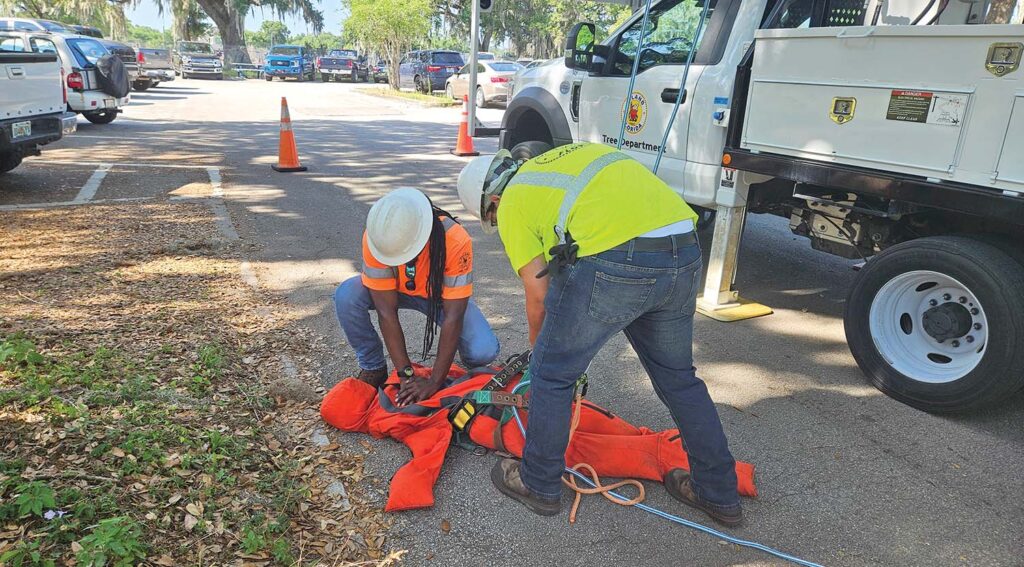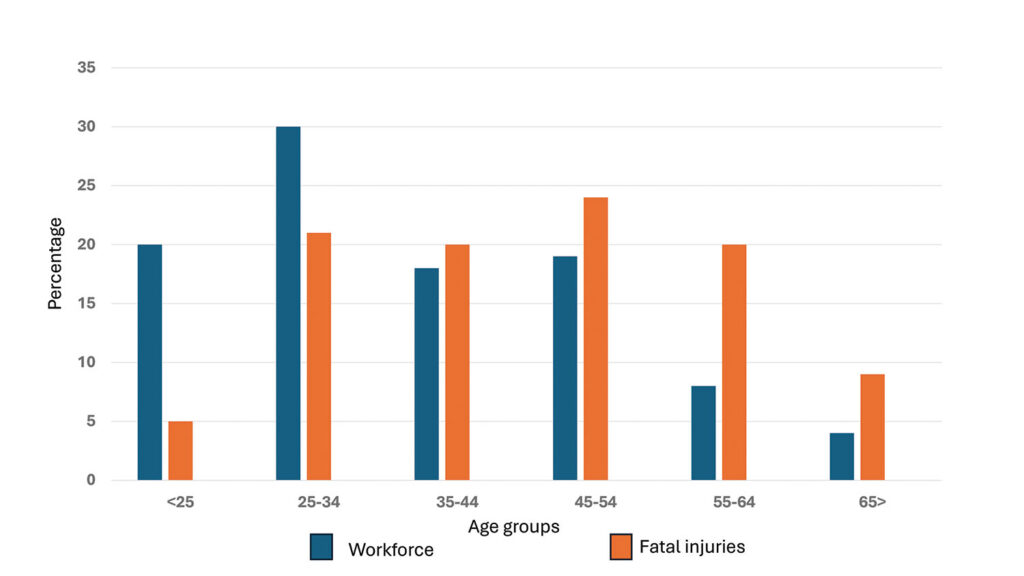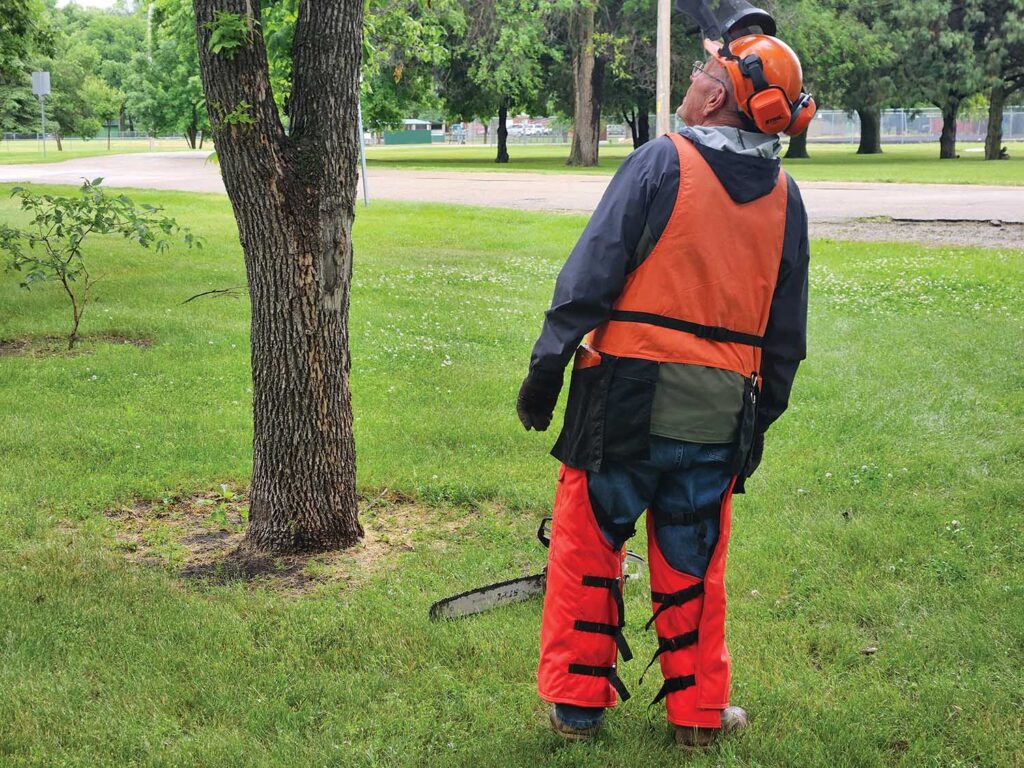Safety Update: The Role of Age in Fatal Incidents

Practicing aerial rescue. Age is irrelevant when it comes to electrical shock. All tree workers – young and old – need to know how to work safely around power lines. All photos courtesy of the author.
They came from tree crews of the largest tree care companies in the United States. They worked alone as the sole proprietor of their own companies. They performed line-clearance work along overhead power lines, pruned trees in residential backyards and removed trees in city parks. They worked for companies with words such as “Tree Experts,” “Tree Service” and “Tree Wiseman” in their name, among many others. What they all had in common was that they died during arboricultural operations.
Most common fatal injuries
These fatal incidents follow along predictable trends, ones we have seen since the 1990s. Most tree-worker deaths can be classified under just three U.S. Bureau of Labor Statistic (BLS) Event or Exposure categories; 1) “Contact with Objects and Equipment,” 2) “Fall, Slips and Trips,” and 3) “Exposure to Harmful Substances or Environments.” There are always fatal tree-worker incidents within the fourth and fifth categories, “Transportation Incidents” and “Violence and Other Injuries by Persons or Animals,” but far fewer than the aforementioned ones.
Peter Gerstenberger, senior vice president, industry support at TCIA, had an article in the April 2024 issue of TCI Magazine titled “Insights Into Accidents in Tree Care.” He reviewed 243 fatal incidents from the BLS Census of Fatal Occupational Injuries (CFOI) that happened during arboricultural operations between 2020 and 2023, inclusive.

Ages, as a percentage, for the tree-worker workforce and fatalities. Courtesy of John Ball.
Breaking it down
Among those 243 fatal incidents, there were 122 incidents that fell within “Contact with Objects or Equipment,” about half of the fatal incidents reviewed. These incidents ranged from being caught-in/compressed-by a brush chipper to being struck by the falling tree during manual tree felling. Struck by a falling tree was, as always, the leading cause of death within the “Contact with Objects and Equipment” event category.
Fatal injuries in the event category “Falls, Slips and Trips” were second in number of incidents. There were 50 incidents reviewed in this event category, about 21% of the total. Many of these incidents were falls from trees, with slightly fewer being falls from aerial devices. There were also falls due to a tree or aerial-device failure. Tree workers not only fall from trees or lifts, but also fall with trees and lifts.
The perpetual third most frequent event category for fatal incidents is “Exposure to Harmful Substances or Environments.” These fatal incidents are almost entirely electrocutions – death from an electric shock. They accounted for about 15% of the fatal incidents in Gerstenberger’s review. Over the decades, the percentage of tree-worker deaths by electrocution from contact with an overhead power line has ranged from 12-20% of the total number of fatal incidents in any given year.
Second look
I conducted a similar review of CFOI data, but over a slightly shorter period within this range, September 1, 2020, to August 31, 2023. The review included 208 fatal incidents over a three-year period, about 69 per year. Gerstenberger calculated a rate of about 61 fatal injuries per year. The two rates are close, considering the short periods of data reviewed.
“Contact with Objects or Equipment” was still the leading category of fatal incidents for tree workers in our review, followed by “Falls, Slips and Trips” and then “Exposure to Harmful Substances and Environments.” Struck by a falling tree during felling operations was the most common contact incident. Climbers falling from trees was the most common “Falls, Slips and Trips” incident, and electrocutions the most common “Exposure to Harmful Substances or Environments.”
This same data could have been collected 10 to 30 years ago without many changes in categories of incidents or their frequency. We do see more stump-grinder incidents than we once did – but still a low percentage of the total fatalities. Some years we see more falls, and then the “Falls, Slips and Trips” event category edges to the number-one spot for fatal incidents. But there is a discouraging sameness to the numbers and the ways tree workers die.
So, let us look at it from a different perspective. What is the role of age in these incidents? Does it differ among the event categories?
Fatal injuries and age
First, tree workers are not a young group. Collectively, landscape-services workers, which includes tree workers, have a median age of 41. If we separate and look at just the tree workers from this group, the median age drops to 36 years. Considering the physical demands of many tree care tasks, the fact that the average tree worker is younger than their counterpart in ground maintenance or landscaping is not too surprising.
But we do have older workers in tree care, and the tails of our demographic curve are nearly equal. There are as many tree workers 19 years old or younger as there are tree workers 65 years old or older; each about 4% of the workforce. But the curve is skewed toward young workers beyond these groups. Twenty percent of the workforce is less than 25 years old, while only 12% of tree workers are 55 years old or older.
The age of 55 years marks the designation as being an older worker. This is the age when we have diminishing capabilities to perform physical tasks. The percentage of older workers is expected to increase as the U.S. population ages. The total U.S. workforce between the ages of 16 and 34 is declining, while the 55-year-old and older age group is increasing. Older workers were 23% of the U.S. workforce in 1999. That increased to 37% by 2017. The tree care industry will see the same trend. This may result in an increase in tree-worker fatalities.
More deaths after 40
The older tree workers, the 55-plus category, account for 29% of the fatal tree-worker incidents. The other tail of the demographic curve, the 24-year-old or younger, is 20% of the workforce but accounts for only 5% of the fatal incidents. The middle demographic group, those tree workers between 35 and 44 years old, comprise about 18% of the workforce and 20% of the fatalities. Once tree workers reach about 40 years old, the fatality rate begins to increase.
Studies from around the globe have documented the trend that older workers, regardless of occupation, have a higher fatality rate than their younger counterparts. The trend is most noticeable in physically demanding occupations that require strength and endurance. The other factor is the risk of injury in a profession. Combine these two factors – occupations with high physical demands and risk – and that certainly includes tree workers.
Nonfatal injuries
Equally interesting, many studies found that the rate for nonfatal injuries is slightly higher for the younger worker, those 18 to 34 years old. They have many of the workers’ compensation claims, including work-related musculoskeletal disorders, but their claims are less expensive. The workers’ compensation claims that are more expensive are among the older workers. These older workers have the longest lost-time claims. Older workers have lower incident rates, but when they do have an incident, the injuries tend to be more severe. They result in long hospitalizations or death.
Less tolerance for impact
There are many reasons for fatalities being skewed toward the older workers across occupations. The reasons most often mentioned are that older workers are slower, overconfident and less coordinated, but these are not always the key reasons. A primary reason for the increase in fatal injuries is that, as we age – regardless of our physical condition – we have less ability to absorb energy.
Traumatic injuries result from the energy transfer to the body from an outside force. The force may be from a moving object, a falling tree for example, or the worker falling to the ground, among many others. Younger workers have a higher tolerance to outside forces that result in traumatic injuries. What will kill a 60-year-old worker might require only a few days of hospitalization for a 20-year-old.

Our profession, as with many others, is rapidly aging. It is not hard to find arborists in their 70s still actively involved in arboriculture.
Fatal injuries by age for different arboricultural activities
The average age of a tree worker killed during arboricultural operations was 41 years old. This was older than the average age of the workforce, but, as already mentioned, older workers have a disproportionate number of these fatal incidents. But the worker age for fatal incidents varied widely among the various event categories.
The oldest average age for a fatal incident was among aerial-lift operators. They were about 52 years old, with a range from 23 to 79 years. The most common cause for these fatal incidents was a fall from an aerial-lift bucket. The next oldest average age for fatal injuries was among climbers. The average climber who suffered a fatal fall was 43 years old, with a range from 32 to 63 years.
While we know the ages of the workers killed in these incidents, what is not known is the average age of workers performing these activities. For example, is the average age of an aerial-lift operator greater than that of a climber?
It is not too surprising that the older of the two were the aerial-device operators. Climbing is a more physically demanding activity, and most tree workers can “fly” an aerial device longer than they can climb.
Falls and struck-bys
Fall fatalities increase with age across many occupations, beginning at 45 years old. While the height of the tree-worker falls, either from trees or lifts, is not known for all these incidents, many were above 30 feet. The higher the height of a fall, the greater the energy. Older workers have less tolerance to this energy transfer on impact with the ground.
The average age of a death from being struck by a falling limb was the same as a climber-fall fatality, though the range of ages of the deceased was wider, 22 to 68 years old. The energy transfer is now a falling object striking a tree worker, rather than a worker striking the ground. The rate of internal bleeding, bleeding around the brain, from a head impact with an object increases with age.
Felling and chipping
The average age of a worker killed during manual tree felling or chipping brush was 38 years old, though the range of ages differed. The range of ages for dying from being struck by a falling tree was 17 to 58 years old, while the range for deaths during chipping was 17 to 50 years old. These averages were only slightly higher than the average age of tree workers. This is not too surprising, as many chipper incidents involve total body fragmentation – age does not matter. The same is true with being struck by a 10-ton falling tree. No one can tolerate that much energy transfer.
Electrocution
The youngest average age for a fatal incident occurred with electrocution from electric contact with an overhead power line. The average age was 35 years old, with a range from 19 to 70 years. This almost mirrors the demographic curve of tree workers.
Electricity is the most unforgiving of our injuries, resulting in a higher ratio of fatal to nonfatal incidents than other arboricultural activities. When a worker contacts a 7.2 kV overhead power line, age becomes irrelevant.
Conclusions
Tree work will not be exempted from this demographic trend toward an older workforce. We will see an aging tree-worker population in the coming years. The older workforce also may translate into an increase in fatal injuries.
Our need to reduce hazards will be even more important as our workforce ages. This means moving to more remote-control systems that can reduce exposure to hazards, such as the increasing use of knuckle-boom-mounted grapple saws. Remote-control systems also should mean fewer workers are needed to complete the same work – a key to our future, which will see fewer, and older, workers.
John Ball, Ph.D., BCMA, CTSP, A-NREMT (Advanced-National Registry of Emergency Medical Technicians), is a professor of forestry at South Dakota State University.




